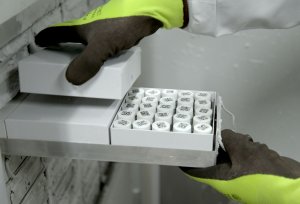Getting Samples from the NEON Biorepository is Now Even Cooler
December 1, 2021
The NEON Biorepository at Arizona State University receives about 100,000 physical samples from the NEON field sites each year—and more than 60% of them need to stay frozen. A 4000 square foot renovation, completed in August 2020, ensures that the Biorepository will have plenty of cryostorage for the 30-year life of the program.
If you're not familiar with the NEON Biorepository, you should be. The now-27,500 square foot Arizona State University Biocollections facility, managed by the Biodiversity Knowledge Integration Center (BioKIC), houses both the NEON Biorepository and ASU's nine other natural history collections in Tempe, Arizona. Most of the physical soil, sediment, water, and organismal samples collected by NEON field technicians are stored here. The samples are more than just a historical archive for the NEON program. They are available for researchers to check out and use for a wide variety of purposes.
The renovation vastly expanded the cryogenic storage capacity for the Biorepository. The facility currently has two liquid nitrogen freezers, which can store up to 100,000 samples each at temperatures of -196°C (-320°F). It also has 12 ultra-low temperature (ULT) freezers for storage at -80°C (-112°F). The facility has enough space for up to 16 large liquid nitrogen freezers and 28 ULT freezers, providing ample room for expansion as the NEON program continues to collect samples over the coming decades. It also houses a liquid nitrogen storage tank, its own back-up generator, and a processing lab.
The freezers hold a multitude of sample types, including frozen bulk samples for microbial analyses of soil and aquatic microbes, DNA samples from terrestrial and aquatic organisms, small mammal blood and tissue samples, insects, and plant tissues. Dr. Kelsey Yule, the ASU Project Manager for the NEON Biorepository, says, "These samples represent the full diversity of all of the things the NEON program studies. Basically, anything that was collected that wasn't used for analysis in creating the NEON data products. And it's all available for researchers to use!"

Biorepository technician pulling samples
About 60-65% of physical samples are stored frozen. The remainder (e.g., prepared slides, pressed and dried plants, preserved and mounted insects, fluid-preserved specimens, mammal skins, skeletons, and skulls) are stored at room temperature. Yule explains, "Different types of samples and different types of analyses require different storage methods. The goal is to preserve the long-term data potential of the samples for any type of analysis researchers may want to conduct on them. In many cases, that means freezing the sample to keep it from breaking down. Having both liquid nitrogen and -80°C freezers gives us options, so we can choose the best storage method for the sample type and the type of analysis researchers may want to conduct."
Samples from the Biorepository can be checked out for both non-destructive and destructive use. Interested researchers submit a request that details which samples they need, for how long, how they will be used, and the scientific value of their work.
Researchers can see what kinds of samples are available (both frozen and unfrozen) by searching the Biorepository Data Portal. They can also reach out to staff at the Biorepository for help at biorepo@asu.edu. Yule says, "We work with researchers to make sure that the samples they are requesting are the best match for the research questions they are interested in, and the analyses they want to perform will be possible with the samples we have. We are continually balancing the needs of the research community with the long-term goal of maintaining a complete 30-year record for the Observatory. But these samples are meant to be used and studied. It's exciting to see the range of questions scientists can explore with them."

